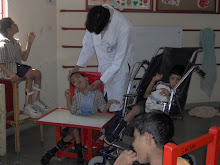Dental care for the visually impaired usually finds itself a chapter in textbooks of special care dentistry and at least a section in pediatric dental textbooks, but a recent experience with the treatment of children with visual impairment left me asking myself... Whose Impairment is it anyway? The patients' or the dentist's.
There are some excellent articles on the subject of how to approach the patient with visual impairment to which I attach the links here (Jaccarino 2009, Watson et al 2010, University of Florida Guidelines). These articles give the dentist an idea of the challenges of treating a patient with visual impairment, however there is another aspect to treating any patient... the human aspect.
An Idea is Born
When one of my interns came up to me and said she wanted to organize a camp for children with Visual Impairment as part of their mandatory community project; I was thrilled. But then came the usual barrage of doubts. "Can we treat such children?", "What are the special precautions we need to take?", "Will they allow us to treat them?".
Managing a child with any special need is always a three way process; the management of the child's needs, the management of the parent's fear and in most cases management of the dentist's own doubts. The treatment needs of children with visual impairment are not very different from those of other children as the literature available on the topic will confirm. However the fear in the mind of the parent combined with the doubt in the mind of the young dentist can often mean that the children who could have received preventive and basic dental care from a general practitioner could end up waiting months to see a "specialist".
The second part of any program is the funding required."Who will sponsor us?" was the next question raised. The traditional approach would be to approach an institution or agency that funds camps like these, and agencies are often skeptical of fresh interns with little or no experience attempting something that (in perception at least) was a difficult task. Very often, the flames of momentum and enthusiasm generated by a noble idea are doused by the cold water of waiting for an official grant. With this in mind the next step was to ask the interns to consider raising funds for this project of theirs.
From Idea to Concrete Plan
Turning the idea into a plan was the next step. In any project, good intentions are a necessary but not sufficient requirement. Transforming the idea into a serious plan that institutions and parents will trust requires planning, persistence and a willingness to pursue the idea regardless of obstacles. When the interns approached the rector of the university with the plan; he suggested a bold move. They would come up with the plan and be responsible for the management of the program. The faculty supervisor (the author) would only guide them and refine their plan; but they were in-charge. This turned a listless set of interns into a determined lot wanting to prove their worth. The program was transformed from an 'idea of the interns' to a 'program of the interns'. The dream of success and glory may be a motivator; but the fear of being actually held responsible for failure is perhaps a far more effective tonic. Within 48 hours a plan was in place that would satisfy the harshest of critics. Furthermore the interns and the faculty supervisor agreed that they would each contribute a nominal amount so as to make sure that the project had enough funds to be implemented even without support. To anyone (and there are a lot of people) who doubts the necessity of planning and paperwork, what happened next is essential reading.
"Build it and they will come..."
The response to the initial call for volunteers was heartening with interns wanting to be a part of what sounded like an interesting idea. But the response to the plan was even better. The Prince Salman Center for Riyadh Children Health(PSCRCH), adopted the plan and agreed to support this and all further programs based on this model. Generous contributions were made towards getting not only a simple camp but also one that would have gifts for the children including a brush and paste.What seemed a distant possibility was now slowly turning into a reality. Even more heartening was the response of the parents. In addition to using the school for children with visual impairment, the interns, with the cooperation of the school managed to secure the phone numbers of the parents of these children. The personal touch of calling the parents to tell them what was being attempted, got an immediate response from the parents. Even those who could not come promised to come for future check-ups and spread the word of the program. What had started off as a camp was transformed into a campaign.
The treatment of the children
Once the ground work was laid there still remained the fear of the interns. An orientation was arranged to cover the basics of dental treatment techniques for children with visual impairment. After this they would then take up the preventive care of children in Phase I.More than just treating, each intern spoke to the parents to get an idea of what problems the children actually faced in the maintenance of oral hygiene. By the end of the day, the fear and apprehensiveness was replaced with an understanding. While some had patients who were co-operative others had patients who were scared; the most important lesson was however, that children with visual impairment are just like any other children. The impairment in sight may be scary for the new dentist; but a supervised hands on experience transformed fear into a genuine realization of ability. There were children who were too scared to face treatment, and there were procedures for which the intern, or the parent or in some cases both preferred that the child be seen by a specialist. There were still limitations to the interns ability to treat; however these were genuine limitations of ability rather than the existing limitations of fear.
Already plans are afoot for a Phase II; involving comprehensive treatment of these children. More schools have come forward to be a part of this program. The interns are using their experience with the parents to come up with their own Arabic audio aids and phone apps to promote oral hygiene among children with visual impairment.The greatest achievement of the day was however the removal of an unjustified fear from the minds of (at least this group of) young dentists.
A journey of a thousand miles begins with a single step, and on a hot Riyadh summer's day, a small group took that first step. There are bound to be obstacles and surely one camp is hardly going to solve all the problems of access to dental care faced by children with visual impairment, but once the fear of treatment has been removed from the mind of the dentist, it is indeed an irreversible step in the right direction.
This camp was possible due to the efforts of Dr Najla AlGamdhi who took the initiative to organize the camp, the Interns and students of the College of Dentistry RCsDP who gave it their wholehearted enthusiasm and the vision of Prof Abdullah Shammery; Rector RCsDP who gave the interns the challenge of organizing their own campaign and allowed them to rise to it.
There are some excellent articles on the subject of how to approach the patient with visual impairment to which I attach the links here (Jaccarino 2009, Watson et al 2010, University of Florida Guidelines). These articles give the dentist an idea of the challenges of treating a patient with visual impairment, however there is another aspect to treating any patient... the human aspect.
An Idea is Born
When one of my interns came up to me and said she wanted to organize a camp for children with Visual Impairment as part of their mandatory community project; I was thrilled. But then came the usual barrage of doubts. "Can we treat such children?", "What are the special precautions we need to take?", "Will they allow us to treat them?".
Managing a child with any special need is always a three way process; the management of the child's needs, the management of the parent's fear and in most cases management of the dentist's own doubts. The treatment needs of children with visual impairment are not very different from those of other children as the literature available on the topic will confirm. However the fear in the mind of the parent combined with the doubt in the mind of the young dentist can often mean that the children who could have received preventive and basic dental care from a general practitioner could end up waiting months to see a "specialist".
The second part of any program is the funding required."Who will sponsor us?" was the next question raised. The traditional approach would be to approach an institution or agency that funds camps like these, and agencies are often skeptical of fresh interns with little or no experience attempting something that (in perception at least) was a difficult task. Very often, the flames of momentum and enthusiasm generated by a noble idea are doused by the cold water of waiting for an official grant. With this in mind the next step was to ask the interns to consider raising funds for this project of theirs.
From Idea to Concrete Plan
Turning the idea into a plan was the next step. In any project, good intentions are a necessary but not sufficient requirement. Transforming the idea into a serious plan that institutions and parents will trust requires planning, persistence and a willingness to pursue the idea regardless of obstacles. When the interns approached the rector of the university with the plan; he suggested a bold move. They would come up with the plan and be responsible for the management of the program. The faculty supervisor (the author) would only guide them and refine their plan; but they were in-charge. This turned a listless set of interns into a determined lot wanting to prove their worth. The program was transformed from an 'idea of the interns' to a 'program of the interns'. The dream of success and glory may be a motivator; but the fear of being actually held responsible for failure is perhaps a far more effective tonic. Within 48 hours a plan was in place that would satisfy the harshest of critics. Furthermore the interns and the faculty supervisor agreed that they would each contribute a nominal amount so as to make sure that the project had enough funds to be implemented even without support. To anyone (and there are a lot of people) who doubts the necessity of planning and paperwork, what happened next is essential reading.
"Build it and they will come..."
The response to the initial call for volunteers was heartening with interns wanting to be a part of what sounded like an interesting idea. But the response to the plan was even better. The Prince Salman Center for Riyadh Children Health(PSCRCH), adopted the plan and agreed to support this and all further programs based on this model. Generous contributions were made towards getting not only a simple camp but also one that would have gifts for the children including a brush and paste.What seemed a distant possibility was now slowly turning into a reality. Even more heartening was the response of the parents. In addition to using the school for children with visual impairment, the interns, with the cooperation of the school managed to secure the phone numbers of the parents of these children. The personal touch of calling the parents to tell them what was being attempted, got an immediate response from the parents. Even those who could not come promised to come for future check-ups and spread the word of the program. What had started off as a camp was transformed into a campaign.
The treatment of the children
 |
| Tell feel do, the first time for both dentist and patient |
 |
| A girl receives a gift from her dentist, but perhaps the knowledge gained by the dentist was the true gift of the day |
A journey of a thousand miles begins with a single step, and on a hot Riyadh summer's day, a small group took that first step. There are bound to be obstacles and surely one camp is hardly going to solve all the problems of access to dental care faced by children with visual impairment, but once the fear of treatment has been removed from the mind of the dentist, it is indeed an irreversible step in the right direction.
This camp was possible due to the efforts of Dr Najla AlGamdhi who took the initiative to organize the camp, the Interns and students of the College of Dentistry RCsDP who gave it their wholehearted enthusiasm and the vision of Prof Abdullah Shammery; Rector RCsDP who gave the interns the challenge of organizing their own campaign and allowed them to rise to it.







